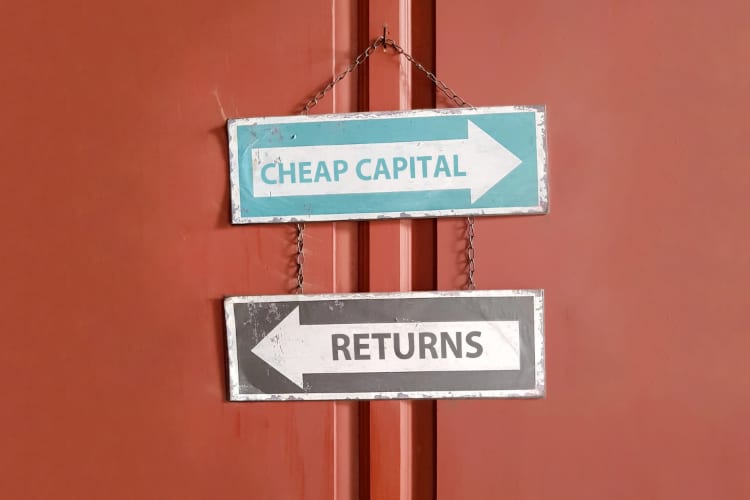Capital no longer cheap, reinsurance returns must stabilise higher: Berenberg

The opportunity cost-of-capital is no longer cheap and therefore reinsurance pricing and returns delivered to ILS investors have to stabilise at higher levels than before, leading analysts at investment bank Berenberg to suggest the hard market will be sustained, while ILS inflows will be moderated for a time.
The analysts have a positive outlook for reinsurance and for the chances of discipline on pricing being sustained for much longer than we’d previously seen, during the era of cheap capital.
Capital raises in 2022 and 2023 so far have been relatively minor, with money most readily flowing to catastrophe bond fund strategies, as well as some sidecar arrangements and a few of the longer-standing collateralized reinsurance strategies, according to our sources.
Berenberg’s analysts note that traditional reinsurance capital raising has also been relatively minor and the outlook for new capital remains subdued, given global macro and capital market conditions.
“We believe the potential for further capital coming in 2023-24 remains low,” the analysts stated.
Backing up their forecast, the analysts point to two key indicators.
First, the consecutive years of losses faced by some insurance-linked securities (ILS) investors, which now mean “investors expect to see hard evidence that these securities can deliver adequate and consistent returns in the face of higher nat-cats.”
Second, “the opportunity cost of capital and thus return hurdle rate is now much higher,” with two-year US treasury yields now at 4% and therefore investors are faced with more options for putting capital to work.
Because of these factors, the Berenberg insurance equity analyst team state, “This means that reinsurance pricing needs to stabilise at a higher level to provide an attractive return.”
Another factor in sustaining higher rates for reinsurance and ILS, is the fact the gap between supply and demand continues to widen, the analysts believe, with inflation driving insurable values up at the same time as capacity remains lower.
“We expect this mismatch to continue to fuel hard market conditions,” the analysts say.
Looking back to the previous softening of reinsurance rates, that was evident since 2010 or so, the analysts believe the low-cost of capital and a period of lower than average catastrophe losses fuelled the softening cycle.
“The number one reason, in our view, for the previous soft cycle (2010-17) was the availability of cheap capital, which manifested via the c30% CAGR growth in alternative capital – mainly from collateralised reinsurance, otherwise known as insurance-linked securities (ILS) – from c$26bn in 2009 to c$95bn 2022. This also coincided with an unusual period of low nat-cat losses,” they explained.
But looking ahead they are more positive, saying, “The current unwinding of a decade- plus of ultra-low interest rates, in conjunction with an increasingly higher nat-cat environment, layered with persistent inflationary pressures, suggest that upwards pressure on reinsurance pricing should persist and that the price of risk will stabilise at a new, higher level.”
The Berenberg analyst team point to Artemis’ data on catastrophe bond multiples and spreads as being “a leading indicator of higher future profitability for reinsurance.”
With catastrophe bonds spreads at a high, of around 10.5% when the analyst report was written, this suggests a renewed need for capital to deliver higher returns, which should help to moderate flows and sustain pricing.
“Although we believe there will be an increase in capital raising and deployment over the course of 2023, in our view the magnitude will not be of the scale required to put significant pressure on rates,” the analysts state.
As the appetite for deploying capital has been subdued by the losses faced and now higher rates elsewhere, “reinsurance pricing has to stay attractive for a rational investor to participate,” they continue.
“Consequently, we anticipate that the hard market will continue throughout 2023 and into 2024.
“Although we anticipate rate rises to slow down into 2024, we do not expect a material deterioration to the new base level of pricing, which raises the prospect of higher returns on capital for reinsurers,” Berenberg’s analyst team forecast.
Because of all these factors, ILS as an asset class may be relatively less attractive to investors, given the optionality they now have in deploying capital to other assets that have risen as capital has become less cheap.
At the same time, the ILS allocation still remains high for some investors, relative to other asset classes, which could drive a continued need for rebalancing, as we discussed in our most recent video interview here.
So, what must the reinsurance and ILS industry do to attract capital back?
“Investors seem to be taking a show-me approach and seem willing to come back to the space when the industry can demonstrate that the new level of pricing can earn an adequate return on the higher cost of capital,” the analysts state.
Adding, “This could mean at least one or perhaps even two full-year results, which suggests the hard market could last for two to three years.”
Prices must remain high, in order to keep investing in ILS and alternative reinsurance capital solutions attractive versus other assets of similar risk-levels, meaning the industry as a whole is much more incentivised to sustain rates at higher levels than before.
The question, as always, will be what happens when capital does begin to flow more meaningfully into the sector?
That’s where discipline will be tested, as well as the appetites of investors and we may finally discover just how much investors value the relative lack of correlation in the ILS asset class.






